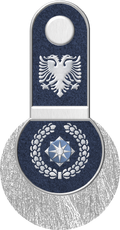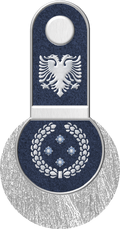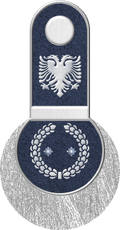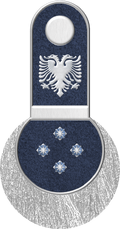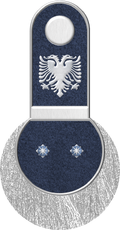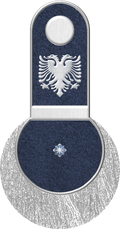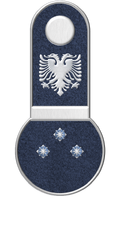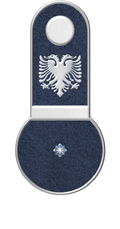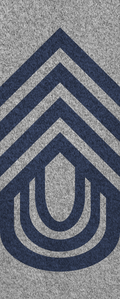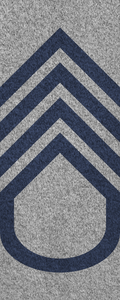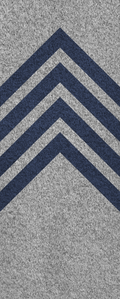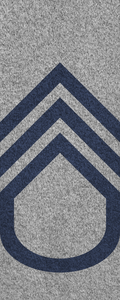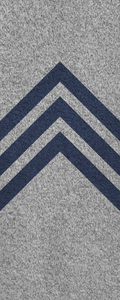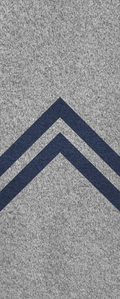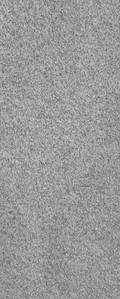| Lordaeron Army | |
|---|---|
 The Lordaeron Army[1] | |
|
Military Type |
Army |
|
Kingdom(s) |
|
|
Size |
None, destroyed |
|
Headquarters
|
Fenris Keep, Lordamere
|
|
Leaders |
|
|
Secondary Leader(s) |
No Information |
|
Engagements |
|
|
Insignia |
Lordaeron Royal Banner |
|
Status |
Destroyed |
The Lordaeron Army was the standing army of the Kingdom of Lordaeron. While it weathered the Orcish Wars, it was all but decimated during the Burning Legion invasion of the Third War.
History[]
Command Structure and Ranks[]
Note: These ranks and information are part of the centralised Grand Alliance Army fanon, and are thus not required to be acknowledged by anyone.
Below are the ranks and insignia used by the Lordaeron Army before its destruction. The name of the rank in Lordaeronian is given in brackets.
General Officers[]
| Grand Marshal General
(Großmarschall-General) |
Marshal General
(Marschal-General) |
|---|---|
Grand Marshal-General (Grand Marshal)[]
Created for leaders of the combined military of the Alliance of Lordaeron, Grand Marshal-General (later renamed to Grand Marshal) was the highest military rank achievable. The last known Grand Marshal was Othmar Garithos.
Marshal-General[]
The supreme leader of the army, the Marshal-General was generally considered to be the most experienced and able officer of the kingdom and, unlike in many other kingdoms, the rank was not normally held by the King of Lordaeron. The General-Marshal also held command of the Central, or Tirisfal, Corps in addition to their command of the entire army. The last known Grand Marshal was Othmar Garithos.
| General
(General) |
Lieutenant General
(Leutnant General) |
Major General
(Feldmeister General) |
Marshal
(Marschal) |
|---|---|---|---|
General[]
The commanders of one of Lordaeron's Army Corps, Generals were some of the most senior officers of Lordaeron, with only six typically holding the rank in peacetime. Five of these generals each commanded a Corps stationed at one of the Kingdom's provinces and assigned to a cardinal point. Each General was hence known by their province, with the General of Silverpine commanding the Western Corps, the General of Hillsbrad commanding the Southern Corps, the General of Darrowmere commanding the Central Corps, the General of Thonmere commanding the Northern Corps and the General of Eastweald commanding the Eastern Corps. The final general, the Knight-General of Lordain was the leader of the Brotherhood of Lordain, which by the fall of the Kingdom was large enough to be counted as a Corps in its own right. In wartime an additional general would also be assigned to command the Kingdom's deployed armies during war time which were typically dubbed the Lordaeron Expeditionary Corps. Under the Forsaken the rank remains known as General, although the prefix of "Dread" is sometimes added, much like with other undead ranks.
Lieutenant General[]
The Executive Officers of a Corps, Lieutenant Generals were promising General Officers assigned to their General as his second-in-command, being able to assume command if he was killed in action or disabled.
Major General[]
Serving as staff officers, Quartermaster Generals and Military Governors, Major Generals were the most diverse General Officer rank of Lordaeron, although they were one of the rarest during peace time. When translated directly from Old Lordaeronian the rank is "Fieldmaster General".
Marshal[]
Legion Commanders, Marshals were typically members of the ruling family of each of the kingdom's Duchies, with the size of Lordaeron causing many legions to make up each Corps. Notably, Marshal is one of the ranks to have been warped the greatest under the Forsaken, with the undead Marshals of Lordaeron typically being known as "High Executors".
Senior Officers[]
| High Commandant
(Oberst Kommandant) |
Commandant
(Kommandant) |
Lieutenant Commandant
(Leutnant Kommandant) |
Major
(Oberst) |
|---|---|---|---|
High Commandant[]
Equivalent to the High Commanders of other kingdoms such as Gilneas, Lordaeronian High Commandants were found leading regiments raised from the borders of the Kingdom, with their holders typically being experienced Margraves. Each Corps would normally have many of these officers, as each had Marches that they were required to protect, with the Eastweald bordering the mountain passes to the south that led to the Hinterlands, Darrowmere bordering both the Alteraci and Elven Marches, Tirisfal also bordering the Alteraci Marches, Silverpine bordering the Gilnean Marches and Hillsbrad bordering the Alteraci and Stromic Marches.
Even legions with no Marches would still have at least one High Commandant, who would be the most experienced Commandant and serve as the second-in-command of the legion. Such High Commandants were typically the leaders of cavalry regiments, much like their superior Marshals. Like Marshals, they are typically known as Executors under the Forsaken.
Commandant[]
The leaders of Lordaeron's many regiments, Commandants, also known as Commanders or, more recently under the Forsaken, Dread Commanders, were typically members of the Kingdom's upper nobility, most commonly Counts, with their regiment raised from their County. Although Lordaeron had a much less martial culture than southern kingdoms like Stromgarde or Stormwind, these noble-born officers were still highly skilled and trained, which, along with access to some of the best armour and weaponry of the kingdom, allowed Lordaeronian regiments to hold their own against those of their enemies.
Lieutenant Commandant[]
Much like the higher-ranking Lieutenant Generals, Lieutenant Commandants served as Executive Officers, in this case of regiments. In contrast to their Commandants, Lieutenant Commandants were less likely to be high-ranking nobility, with barons and knights (and very rarely commoners) being able to rise to this position.
Major[]
The lowest-ranking, and most common, Senior Officers, Majors (know as "Obersts" or "Chiefs" in Old Lordaeronian) were the commanders of battalions. Although they could come from all ranks of knighthood and lower nobility, most Majors were Viscounts, with their units having evolved from the levies raised from their Viscounties and vassels. Majors could also be found directly under the command of Marshals, where they would serve as Quartermasters and Staff Officers.
Junior Officers[]
| Captain
(Kapitän) |
Lieutenant
(Leutnant) |
Under-Lieutenant
(Unterleutnant) |
Ensign
(Fahnrich) |
|---|---|---|---|
Captain[]
The highest-ranking Junior Officers, Captains were Company Commanders and, like most other officers, mostly noble-born, in this case many would hold the rank of Baron. In fact, Captain was the lowest true "titled noble" officer rank in the Army, with the nobles of earlier centuries being inducted at this rank.
Lieutenant[]
The seconds-in-command of companies, Lieutenants were the highest rank of "knightly" officer, with many being landed knights or esquires. The rank also served as a merging point between the noble and knightly classes of the army, with many Lieutenants also being the sons of the nobility, which led to the rank's original name of "Lord Lieutenant". Lieutenants were typically found in the back lines of battles, being kept out of harms way in the case that their Captain was killed.
Under-Lieutenant[]
Equivalent to the Second Lieutenants of the modern Grand Alliance Army, Under-Lieutenants were the lowest rank of officers to command soldiers. Known as "Knight Lieutenants" originally, Under-Lieutenants were generally given the command of platoons, with the majority of their members being knights as the rank's original name implies.
Ensign[]
The lowest officer rank, Ensigns were "Apprentice Officers", with the rank typically being held by young boys who were charged with signalling and bearing the banners of the army, thus giving the rank its name.
Under-Officers[]
| Under-Officer of the Army
(Unteroffizier zu Heer) |
Chief Under-Officer
(Oberst Unteroffizier) |
Head Under-Officer
(Haupt Unteroffizier) |
Under-Officer
(Unteroffizier) |
|---|---|---|---|
Under-Officer of the Army[]
The highest enlisted rank of the Lordaeronian Army, the Under-Officer of the Army served as the direct liaison between the Lordaeron High Command and the enlisted personel, along with serving as the Chief Under-Officer of the Tirisfal Corps.
Chief Under-Officer[]
Much like the other Under-Officers, Chief Under-Officers served as the highest-ranking Enlisted Officer for a unit, in this case serving a General and his Corps. As such, there were only five Chief Under-Officers at one time.
Head Under-Officer[]
The highest-ranking Enlisted Officer in a legion, Head Under-Officers served much like the other Under-Officers, as advisors and liaisons of their Marshal.
Under-Officer[]
The most numerous rank of Under-Officer, standard Under-Officers served as the Enlisted Officer of a Regiment and were typically a member of their Commandant's household, such as his Captain of the Guard or Constable.
Senior Enlisted[]
| Chief Sergeant
(Oberst Feldmeister) |
Head Sergeant
(Haupt Feldmeister) |
Sergeant
(Feldmeister) |
Chief Corporal
(Oberst Korporal) |
|---|---|---|---|
Chief Sergeant[]
The highest-rank of Sergeant, Chief Sergeants served much like the higher-ranking Under-Officers as advisors to Majors and battalions.
Head Sergeant[]
The Enlisted Officers of companies, Head Sergeants advised their Captains and looked out for the well-being of their unit's enlisted personnel. Much like Chief Sergeants and Under-Officers, they were typically members of their Lord-Captain's household.
Sergeant[]
Translated to "Fieldmaster" in Old Lordaeronian, Sergeants typically served as the seconds-in-command of platoons, although at times of need or in certain regiments or battalions they would command a platoon. This rank, along with other Sergeants evolved from the Mounted Warrior class known as the Serjeanty. Sergeants would have their rank name changed depending on their division:
- Infantry - Fieldmaster/Feldmeister
- Cavalry - Ridemaster/Rittmeister
- Artillery - Cannonmaster/Kannonmeister
- Marines - Seamaster/Seemeister
- Logistics - Quartermaster/Vorratmeister
- Signals - Buglemaster/Kornetmeister
- Magi - Magemaster/Magiermeister
- Medical/Chaplains - Lightmaster/Lichtmeister
Chief Corporal[]
The Enlisted Officers of platoons, and sometimes seconds-in-command, Chief Corporals were more correctly junior sergeants who were being trained in the administration duties required for that rank.
Junior Enlisted[]
| Corporal
(Korporal) |
Private First Class
(Gefreiter) |
Private
(Soldat) |
Recruit
(Rekrut) |
|---|---|---|---|
Corporal[]
The highest-ranking of the junior enlistedmen, Corporals led squads of between six and ten men. This was the first enlisted rank that required certain traits to advance to, as lower ranks simply required training and time.
Private First Class[]
Veteran soldiers, Privates First Class were generally either experienced soldiers or those who had been selected for advancement to Corporal, where in which case they would serve as the second-in-command of their unit. The rank's Old Lordaeronian name "Gefreiters", which translates to "Exempted" in Common, evolved from the "Immunes" class of the Arathorian Legions, which, like the original Gefreiters, was "Immune" or "Exempted" from the duties of other Privates such as fortification building and standing watch, along with gaining better pay and food.
Private[]
The standard soldiers of the Lordaeronian Army, Privates were extremely numerous, with all that was required for advancement to that rank being experience in earlier centuries or completion of basic training in later ones.
Recruit[]
The newly conscripted, levied or enlisted members of the army, Recruits were soldiers in training, which amounted to a short demonstration on how to use a polearm in the early army and later evolved into a longer basic training course by the Second War. However, by the time of the Third War and Lordaeron's fall, the basic training had been dropped, with new Recruits being thrown into battle as soon as they were levied in an attempt to halt the rising undead forces.
Units and Organisations[]
- First Legion
- Second Lordamere Guard Regiment
Divisions[]
Infantry[]
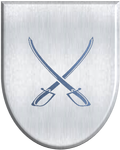

The largest division of the Lordaeron Army, the Infantry was the army's main fighting force and was administrated by a Major General holding the post of "Königlich Feldmeister" or "Royal Fieldmaster".
Formed into a number of Legions, the Infantry was divided among each of the Corps of the army and consisted of around 250,000 men at the time of the Second and Third Wars. Each Legion consisted of between five and ten Kontingents des Infanterie or Regiments of the Foot, each of these regiments numbering 1000 men on paper and commanded by a Kommandant.
Each regiment was further divided into two Line Battalions of 500 men, along with a number of additional militia battalions of the same size that served as a reserve force. Each of these battalions was led by a Oberst(Major) and made up of five 100 strong companies, each led by a Kapitän(Captain), of which two would normally be of archers or later riflemen and three would be of footmen and armsmen.
Companies were further divided into a number of Trupps or Troops, consisting of 25 men and led by a Under-Lieutenant or Sergeant. These were further divided into three to four sections of six to eight men, each led by a Corporal.
The Infantry of the Lordaeron Army bore the device of two crossed broadswords, blue on silver, as their arms.
Brotherhood of Lordain[]
For more information see the Brotherhood of Lordain
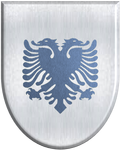

The national Order of Knighthood of the Kingdom of Lordaeron, the Brotherhood of Lordain or the Brunderschaft von Lordain served as the heavy cavalry and elite forces of the Lordaeron Army. The only unit with the right to bear the Royal Arms of Menethil as their personal division crest, the Brotherhood was considered by many to be the most prestigious of the army's divisions.
Much like the infantry division, the Brotherhood was divided into multiple sub-units, each assigned to a certain area. All units were a part of the Brunderschaft, a Corps-sized unit commanded by the Rittergeneral von Lordaeron or "Knight-General of Lordaeron" that consisted of around 50,000 men during the Second War.. This unit was split into five Orden(Orders), Legion-sized units which were each assigned to one of the army's five Corps. These were led by the Rittermarschals or "Knights-Marshal".
Each Order was further split into around ten Kapitels(Chapters), which were led by Ritterkommandants(Knights-Commander). Chapters were further split into squadrons commanded by Ritterseigers(Knights-Champion), the equivalents of Majors. These battalions were split companies commanded by Ritterkapitäns(Knights-Captain), and further divided into troops led by Rittmeisters(Knightmasters). The smallest unit consisted of six to eight men led by a Hauptritter(Head Knight), the equivalent of a Corporal.
As stated previously, the Brotherhood bore the Royal Arms of Menethil as their division arms, a blue double-headed eagle upon silver.
Royal Artillery Corps[]
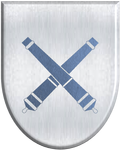

The siege and engineering specialists of the Lordaeron Army, the Royal Artillery Corps wa one of the youngest of the army's divisions. Based out of Stratholme, it consisted of the entirety of the Kingdom's land artillery and include many dwarven personnel alongside the normal humans.
Much like the infantry, the artillery was divided into a number of regiments, known as Kontigents des Kannon or Regiments of Cannon in Old Lordaeronian. The entirety of the corps was led by a Major General holding the position of Cannonmaster General.
The division coat of arms of the Royal Artillery Corps displayed a pair of crossed cannon, blue on a silver.
[]
For more information see the Lordaeronian Marine Corps
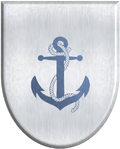

Technically a part of both the army and the navy, the Royal Naval Corps or Lordaeronian Marine Corps was tasked with the defence of the navy's docks and ships, along with boarding actions and naval landings. It was led by the General zur Marine or General of Marines, a General who served on the Lordaeronian Naval Board.
The division coat of arms of the Royal Artillery Corps displayed an anchor and like the others, was blue on silver.
Logistics[]
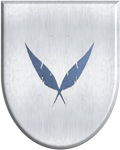

.
.
.
.
.
Signals[]
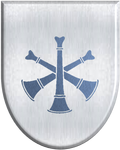

.
.
.
.
.
Lordaeron Circle of Magi[]
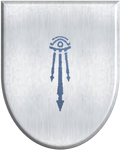

.
.
.
.
.
Chaplain and Medical[]
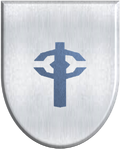

.
.
.
.
.
Uniforms[]
Notes and References[]
- ↑ Image was taken from the Warcraft Total War Conversion Website for fair use.
